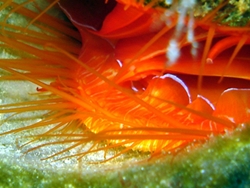 |
Date Announced: 17 Apr 2013
An ongoing study at UC Berkeley used Surface Optics Corp.’s 710-VP hyperspectral imaging system to collect data on the reflective tissue of marine organisms called ‘disco clams’.
Commonly known as “electric flame scallops” or “disco clams”, the Ctenoides ales organism produces a flashy light display that is unique among bivalve mollusks. By rolling and unfurling an iridescent lip, the disco clam creates a strobe effect of blue light, whose mechanism had previously been unknown.
Berkeley graduate student Lindsey Dougherty studies the disco clams and her research recently caught the attention of national media after she presented her findings at the Society for Integrative and Comparative Biology annual meeting.
Dougherty’s research determined that the light display is a result of reflective tissue that is only present and visible on the clam’s unfurled mantle tip.
“Light is incredibly important in the ocean, whether it’s pigment or structurally based coloration, camouflage, reflectance, fluorescence or bioluminescence. The uses of color and light are incredibly important in intra and interspecific communication, so understanding more about the properties of the light in an environmental context is an important step to understand how the signals are produced and perceived,” said Dougherty. “The ability to capture an image of the entire organism as well as its surroundings is a huge step forward in this analysis.”
Surface Optics loaned the SOC710-VP hyperspectral imager to Dougherty and Berkeley’s Caldwell Lab for use in her continuing research on the mechanics and behavioral purpose behind the disco clam light show.
“The HSI [hyperspectral imager] is superior to a point measurement spectrometer in looking at transitions between reflectance spaces. Additionally, having a single image of the entire tissue or organism eliminates the possibility of changes in external conditions, which can occur between single shots using a point measurement spectrometer,” said Dougherty. “It also drastically reduces the amount of time and effort that go into collecting data, as a single picture will give data for every single pixel. The power of that tool contributes exponentially to data acquisition and comparative analysis.”
The ideal hyperspectral camera for applications in precision agriculture, forestry, mining and oceanography, the portable SOC710VP® delivers real-time, research-grade results with a wavelength range of 400 – 1000 nanometer.
To read the entire interview with researcher Lindsay Dougherty on her work with the SOC710 and disco clams, visit http://surfaceoptics.com/hyperspectral-imaging-soc710-disco-clams/
E-mail: erind@surfaceoptics.com
| © 2025 SPIE Europe |
|